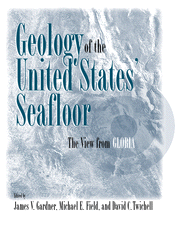Book contents
- Frontmatter
- Contents
- Contributors
- Foreword
- Introduction
- Part I The GLORIA System and Data Processing
- Part II U. S. East Coast EEZ
- Part III Gulf of Mexico and Caribbean EEZ
- Introduction
- 5 Breaching the Levee of a Channel on the Mississippi Fan
- 6 Morphology of Carbonate Escarpments as an Indicator of Erosional Processes
- 7 Sedimentary Processes in the Salt Deformation Province of the Texas-Louisiana Continental Slope
- 8 Sedimentary Processes in a Tectonically Active Region: Puerto Rico North Insular Slope
- 9 A Review of the Tectonic Problems of the Strike-Slip Northern Boundary of the Caribbean Plate and Examination by GLORIA
- Part IV U. S. West Coast EEZ
- Part V Alaskan EEZ
- Index
5 - Breaching the Levee of a Channel on the Mississippi Fan
Published online by Cambridge University Press: 25 January 2010
- Frontmatter
- Contents
- Contributors
- Foreword
- Introduction
- Part I The GLORIA System and Data Processing
- Part II U. S. East Coast EEZ
- Part III Gulf of Mexico and Caribbean EEZ
- Introduction
- 5 Breaching the Levee of a Channel on the Mississippi Fan
- 6 Morphology of Carbonate Escarpments as an Indicator of Erosional Processes
- 7 Sedimentary Processes in the Salt Deformation Province of the Texas-Louisiana Continental Slope
- 8 Sedimentary Processes in a Tectonically Active Region: Puerto Rico North Insular Slope
- 9 A Review of the Tectonic Problems of the Strike-Slip Northern Boundary of the Caribbean Plate and Examination by GLORIA
- Part IV U. S. West Coast EEZ
- Part V Alaskan EEZ
- Index
Summary
Abstract
GLORIA images of the youngest channel on the Mississippi Fan indicate that it has not been a stable feature, but instead has shifted its course several times. A detailed study of a site of channel shifting found a complex stratigraphy that resulted from one episode of channel avulsion. The channel avulsion appears to have been initiated by a large mass flow that choked the channel below the point where the levee was breached and additionally spilled a large volume of material through the breach in the levee onto the adjacent fan. Subsequent flows were redirected through this breach in the levee and built a channel-levee complex over the mass movement deposits. A second phase of mass movement resulted from another large mass flow that came down the channel and triggered the collapse of part of the newly developed levee. In this case, locally derived levee sediment was mixed with allochthonous sediment from farther up the fan and was spread northward from the levee. This localized study suggests that fan stratigraphy is complex and variable at several scales, not just at the scale resolved in seismic stratigraphic studies (Weimer 1989) and that large mass flows capable of choking the channel system have been an important mechanism in redirecting sedimentation on the Mississippi Fan.
Introduction
Channels on deep-sea fans are conduits through which sediments are transported to the distal part of the fan (see Mutti and Normark 1987 and Shanmugam and Moiola 1991 for summaries).
- Type
- Chapter
- Information
- Geology of the United States' SeafloorThe View from GLORIA, pp. 85 - 96Publisher: Cambridge University PressPrint publication year: 1996

